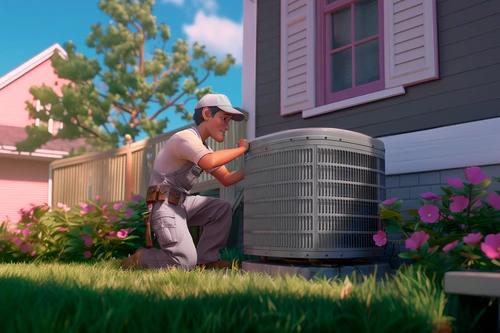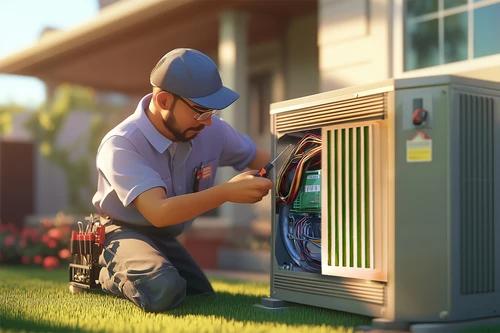Why Is My House So Cold Even With the Heating On?

Imagine you’re wrapped in your favorite blanket, and the heater is running in the background, yet you’re still shivering. Why is that? Several factors – ranging from poor insulation and air leaks to an inefficient heating system – can make your house feel cold, even when the heating is on. HVAC.com explains the common causes and solutions for a cold house in the winter, so you can go back to feeling warm and cozy again.
Leaky Ducts
Is your house cold even with the heating on? Your air ducts could be to blame. Up to 20% of conditioned air can escape through cracks and holes in your ductwork, according to Energy Star. Poor insulation can also lead to air loss. Leaky ducts are a big problem because they allow warm air to escape before reaching the intended rooms, leading to reduced heating efficiency and causing temperature imbalances that make some areas feel colder than the thermostat setting.
Solution: You can address leaky ducts by finding and sealing any gaps or cracks with duct sealant or mastic. If you’re unsure where the leaks are or there’s extensive damage to your ducts, consider hiring a professional to inspect and repair them to ensure the job is done right.
Inefficient or Aging Heating System
An outdated or poorly maintained heating system, or one that’s the wrong size for your home, can struggle to heat your space effectively. This can leave some rooms – especially in the farthest corners of your home – cold, even when the system is running.
Solution: To improve your home’s heat distribution, consider checking your ductwork for leaks; adding more insulation to walls, ceilings, and attics; or installing a zoning system. An HVAC zoning system lets you control the temperature separately in different areas of your home, ensuring that rooms that need more heat receive it without wasting energy on rooms that are already comfortable.
If your heating system is old and inefficient, consider installing a new one. Although it’s a significant investment, you can recoup some of the costs through lower energy bills and fewer repairs, and you’ll experience a more comfortable home during the winter months.
Blocked or Closed Vents
All air vents should be open and unobstructed to maintain proper airflow throughout your home. Vents that are partially or completely closed or blocked by furniture or carpets can restrict airflow, leading to certain rooms feeling colder than others.
Solution: Regularly check your air vents to ensure they’re fully open and free from obstructions.
Poor Insulation
Low insulation levels can allow warm air to escape, making your home feel colder in certain areas. This forces your HVAC system to work harder to maintain a comfortable temperature which can drive up energy bills and increase the likelihood of system breakdowns over time.
Solution: Inspect insulation, especially in attics, walls, and floors, and consider hiring a professional to add insulation where it’s needed. Improving insulation will help your system run more efficiently, saving energy and keeping your home more comfortable.
Drafts and Air Leaks
Gaps around windows and doors can let cold air seep in, causing your home to feel colder. Even small cracks can lead to significant heat loss, forcing your heater to work overtime to maintain a steady temperature.
Solution: Seal any gaps or cracks with weatherstripping or caulking to block drafts and improve heating efficiency.
Cold Floors
Walking on cold floors in the morning is incredibly uncomfortable. If you have tile or wood floors, they can feel especially cold during the winter, making your entire room feel chillier. This is especially true in homes with little or no carpeting, where floors absorb and retain cold air.
Solution: You can combat cold floors by adding area rugs or installing a radiant floor heating system. These solutions will add warmth and comfort to your floors to help the whole room feel warmer. And don’t forget to invest in a cozy pair of slippers!
Using Curtains or Blinds Improperly
Keeping curtains or blinds closed during the day can prevent sunlight from naturally warming your home, making it feel colder. Opening them allows sunlight to enter and add warmth.
Solution: Open curtains and blinds during the day to let the sun’s warmth in, and close them at night to retain heat and keep the warmth inside.
Low Humidity
Low indoor humidity can make your home feel colder because dry air doesn’t retain heat as effectively as moist air. As a result, you may lose body heat more quickly, and your home can feel chillier, even if the thermostat is set to a comfortable temperature.
Solution: Install a whole-house humidifier as part of your HVAC system. Unlike portable units, which only provide moisture to one room, a whole-home humidifier balances humidity levels throughout the house, improving comfort and helping your home feel warmer.
Clogged Air Filter
A clogged air filter can restrict airflow and lead to uneven heating, causing your system to work harder and leaving rooms feeling colder.
Solution: Check your air filter regularly and replace it every 1-3 months based on usage patterns and the manufacturer’s guidelines. Also, invest in annual furnace maintenance to ensure your system is clean and operating efficiently.

